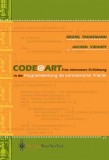Code@Art

Abstract
Code@Art is the first book offering an introduction into programming for artists, designers and media scientists.
Attending to the computer as an artist and using it as a tool of artistic practice has generated manifold new forms of art with and through media (interactive art, computer music, electronic literature, etc.). Although generally hidden, the underlying algorithmic structures and the ongoing confrontation with the program code are essential for many of the works. The term “Software Art” is indicative of a new way in dealing with program codes. “Software Art” is defined as a shift of perspective, away from screens, projections and installations with their ostensible interactive possibilities, towards an examination of the systems and processes lying underneath. Algorithmic structures and their importance as artistic tools have moved to the spotlight. The humanities, too, especially recent media studies, have begun to look into media needs in literature, culture and art. A first step to understand the structure and the potential of computer-based media types is to examine technical and scientific requirements of the respective medium. The programmable machine is at the core of the relationship between artistic practice, computer science and media theory examined so little up to now.
The book investigates the impact of programming on the artistic practice and it attempts to thoroughly acquaint the artist with programming. Java serves as an object-oriented and platform-independent programming language. Supplementary materials and all sample programs are available on the corresponding website. Thus, the book and the website taken together not only offer a different introduction into programming, but serve as a basis and a source for implementing own projects. All source codes are freely available through a sort of toolbox (CODE.KIT) and may be adopted without reservation to one’s own project needs or used within new contexts.

